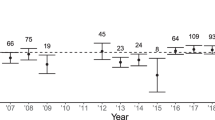Summary
We observed the sex ratios and age composition of courting, nesting, and nonbreeding birds (in clubs) in four breeding colonies of Herring Gulls in Maine and New York. Breeding pairs, with eggs or chicks, often contained an immature male, but rarely contained an immature female. Similarly, courting pairs contained immature males, but rarely immature females. A higher proportion of courting pairs contained immatures compared with pairs with eggs or chicks. In all four colonies there was an excess of females in the clubs. A simulated colony which assumed unequal survival for males and females had an age ratio for unpaired birds that was similar to the observed values. We conclude that in Herring Gulls, mate competition exists and stems in part from an unequal tertiary sex ratio.
Similar content being viewed by others
References
Altmann SA, Wagner SS, Lenington S (1977) Two models for the evolution of polygyny. Behav Ecol Sociobiol 2:397–410
Bianki VV (1977) Gulls, shorebirds and alcids of Kandalaksha Bay. Proc Kandalaksha State Reserve 6:107–118
Bonner WN (1964) Polygny and super-normal clutch size in the Brown Skua, Catharacta skua lonnbergi (Mathews). Br Antarct Surv Bull 3:41–43
Conover MR, Miller DE, Hunt GL Jr (1979) Female-female pairs and other unusual reproductive associations in Ring-billed and California Gulls. Auk 96:6–9
Darwin C (1871) The descent of man and selection in relation to sex. Murray, London
Dwight J (1920) The plumages of gulls in relation to age as illustrated by the Herring Gull (Larus argentatus) and other species. Auk 37:262–268
Dwight J (1925) The gulls (Laridae) of the world: their plumages, moults, variations, relationships and distribution. Bull Am Mus Nat Hist 52:63–401
Emlen ST, Oring LW (1977) Ecology, sexual selection and the evolution of mating systems. Science 197:215–223
Fitch M (1980) Monogamy, polygyny, and female-female pairs in Herring Gulls. Proc Colonial Waterbird Group 3:44–48
Hunt GL Jr (1980) Mate selection and mating systems in Seabirds. In: Burger J, Olla B, Winn H (eds). Behavior of marine animals, vol. 4: Marine birds. Plenum Press, New York
Hunt GL Jr, Hunt MW (1977) Female-female pairing in Western Gulls. Science 197:1466–1467
Hunt GL Jr, Wingfield JC, Newman A, Farner DS (1980) Sex ratio of Western Gulls on Santa Barbara Island, California. Auk 97:473–479
Ingolfsson A (1969) Sexual dimorphism of large gulls (Larus sp.). Auk 86:732–737
Lack D (1968) Ecological adaptations for breeding in birds. Methuen, London
Mills JA (1973) The influence of age and pair-bond on the breeding biology of the Red-billed Gull (Larus novaehollandiae). J Anim Ecol 42:147–162
Monaghan P, Duncan N (1979) Plumage variation of known-age Herring Gulls. Br Birds 72:100–103
Orians GH (1969) On the evolution of mating systems in birds and mammals. Am Nat 103:589–603
Poor HH (1946) Plumage and soft-part variations in the Herring Gull. Auk 63:135–151
Ryder JP (1975) Egg-laying, egg size, and success in relation to immature-mature plumage of Ring-billed Gulls. Wilson Bull 87:535–542
Ryder JP (1978) Sexing Ring-billed Gulls externally. Bird-Band 49:218–222
Ryder JP, Somppi PL (1979) Female-female pairing in Ring-billed Gulls. Auk 96:1–5
Schreiber RW, Schreiber EA (1979) Notes on measurements, mortality, molt and gonad condition in Florida West Coast Laughing Gulls. Fla Field Nat 7:19–23
Shugart GW (1977) A method for externally sexing gulls. Bird-Band 48:118–121
Shugart GW, Southern WE (1977) Close nesting—a result of polygny in Herring Gulls. Bird-Band 48:276–277
Tinbergen N (1963) On adaptive radiation in gulls Tribe Larini. Zool Meded 39:209–223
Verner J (1964) Evolution of polygamy in the Long-billed Marsh Wren. Evolution 18:252–261
Wittenberger JF (1976) The ecological factors selecting for polygny in altricial birds. Am Nat 110:779–799
Wooller RD, Coulson JC (1977) Factors affecting the age of first breeding of the Kittiwake Rissa tridactyla. Ibis 119:339–349
Author information
Authors and Affiliations
Rights and permissions
About this article
Cite this article
Burger, J., Gochfeld, M. Unequal sex ratios and their consequences in Herring Gulls (Larus argentatus). Behav Ecol Sociobiol 8, 125–128 (1981). https://doi.org/10.1007/BF00300824
Received:
Accepted:
Issue Date:
DOI: https://doi.org/10.1007/BF00300824




